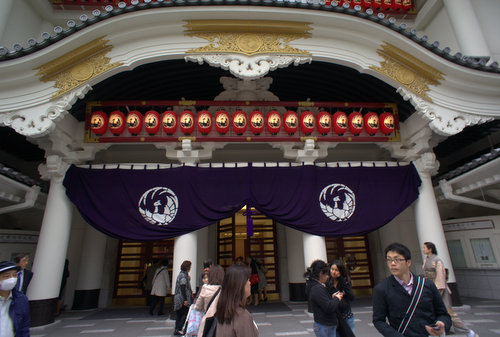Kabuki in Tokyo
As my taxi rounded the corner in Tokyo’s Ginza district, the crowd shifted. Suddenly there were more kimonos present than seen all day. The answer why lay close. It was midday and nearly time for the matinee performance at Japan’s National Kabuki Theater.
I had tickets to attend a traditional Kabuki play at the Japanese National Theater. The Kabuki experience is similar to going to opera for many. One usually dresses up and prepares for the experience – often performed in a stylized language with ritualized actions. The day I attended, there were very few gaigin, or non-Japanese, in the audience. A few men were dressed in formal, traditional robes and many women in kimonos, plus freshly coiffed hair, couture suits and jewels. It was a Thursday afternoon matinee and surprisingly most every seat was taken.
The crowd was very attentive, some with binoculars, many with thick books open on their laps, where they followed much of the action and dialogue by tracing the Kangi characters with fingertips. Box seats next to the stage had floor seating with back rests. I watched an elderly man carefully climb into the box closest to the stage and slowly arrange his robes, then becoming absolutely still as the performance began.
For all the formality, during the play, from time to time, men would shout out approval or short comments to the stage. These shouts were part of a traditional ritual and signaled approval of favorite actors, notable lines of poetry and important character entrances.
The stage was wide and shallow. Most of the action took place in the center of the stage or with actors entering on a long walkway from the back of the theater on the main floor. From where I sat, it was hard to see the performers entering on the walkway until they were nearly onstage, but their voices carried into the rafters. No women appeared, but there are famous women characters and each is performed by male actors. The afternoon performance unfolded with two short plays in which the audience was let in on the joke or main plot twist, then waited to see how the actors would deliver the goods. It was quite a contrast to western theater traditions.
Another contrast was encountered in the lobby where there were expected refreshments including tea and coffee, but also several stalls with expensive gift items and one with an open grill where fish-shaped cookies were filled with tasty, sweet red bean paste and toasted moments before being served. Their aroma was nearly impossible to resist.
I had expected the Kabuki experience to be like taking a medicine that you knew would be good for you – not easy but interesting. What made it come to life was hearing an English translation through an earpiece that could be rented near the entrance. The narration closely followed the action and not only explained what was going on but gave a bit of historical context and included explanations of the audience’s responses.
Kabuki is a deep and rich tradition that includes poetry, costume, make up and ritualized action developed over centuries, yet the afternoon I attended it was vitally alive and the audience very engaged. Western theater should be so fortunate.
Photo courtesy of the author, Elaine J. Masters
